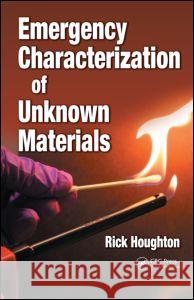Emergency Characterization of Unknown Materials » książka
Emergency Characterization of Unknown Materials
ISBN-13: 9780849379680 / Angielski / Twarda / 2007 / 328 str.
Deliberately, accidentally, or consequentially, first responders and waste site workers handle unknown substances of varying degrees of danger every day. Unidentified chemicals involved with clandestine production of WMD agents or drugs, explosive materials, unlabeled waste, and forensic samples all pose a threat to the worker and those they protect. A straightforward, concise handbook of practical strategies is needed to perform effective risk assessment and management in the face of uncertainty. Written for emergency workers responsible for the safe response to and management of unknown hazardous materials, Emergency Characterization of Unknown Materials providesreadily applicable strategies for developing and implementing a fluid concept of risk analysis based on hazard characterization in emergency situations where definitive identification of the material may be impractical or even impossible. Using a hands-on approach involving the manipulation of small amounts of material, the author discusses strategies to identify threats and vulnerabilities, ascertain exposure, and reduce or eliminate impact. The book begins with an overview of chemical and physical terms and definitions. It continues with a look at types of hazards presented by chemical compounds and mixtures, organisms, and radiation sources. It covers approximately 63 portable technologies for field identification or characterization and examines general technological advantages and disadvantages relative to hazard identification. The final chapter presents strategies for use in identifying or characterizing suspected weapons of mass destruction, illegal drugs, explosive substances, biological hazards, and other hazardous materials. Each chapter includes extensive references and a comprehensive index. Providing a sweeping overview of hazards and emphasizing risk analysis and public safety, Emergency Characterization of Unknown Materials gives first responders an advantage they deserve.











